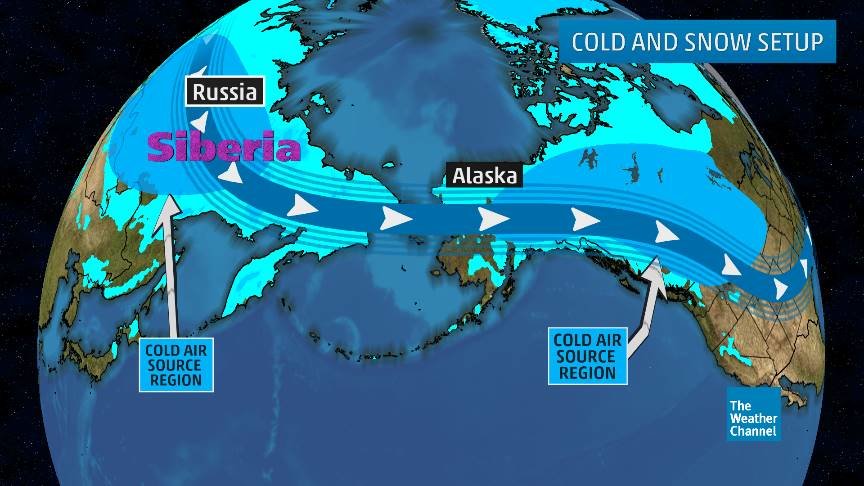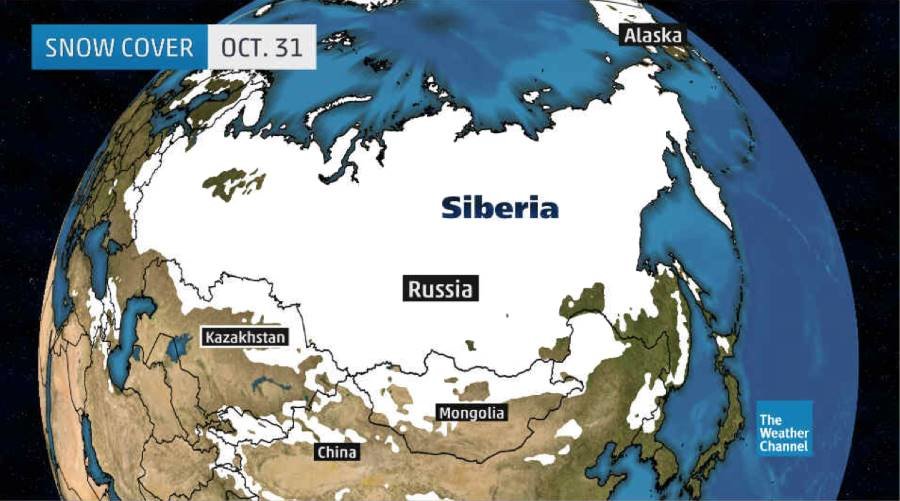A look at how snow in Siberia affects the U.S. and why it's looking like the eastern and central United States will have a cold, snowy winter.
Siberia is known to be one of the coldest places on the planet, but exactly how cold and snowy it gets each year has big ramifications elsewhere on the globe.
In North America, a more snow-covered Russia means that colder air will have an easier time harvesting in Siberia and departing for our continent's heartland. Early in the calendar year, the air coming from Siberia can be cold enough to bring snow to even more southern reaches of the United States if the pattern sets up correctly.
The Extent of Snow Cover
Snow is covering the ground across most of Russia, including all of Siberia - likely the greatest extent of snow cover since 1998. Below is the current snow cover in northern Asia as of Oct. 31.
Some locations, including Sakha in east-central Russia, are seeing their snowiest winter on record, with most of the snow season yet to come. Nearly 10 feet of snow fell in some places in Siberia in just three days, according to the Government of Sakha.
Snow cover in Russia can vary quite a bit from year to year and tends to oscillate over longer periods. You can notice here on snow cover maps dating back to 1998 from NOAA's National Centers for Environmental Information that there has been a general increase in snow cover each year since 2013.
See snow (white) and ice (yellow) cover in Asia on October 31, 1998 - 2016 here.
"In the fall across Eurasia but mostly Siberia the advance of snow cover leads to the formation of the Siberian High. If the advance of snow cover is rapid this leads to a stronger and colder Siberian high" explains Judah Cohen, Ph.D., Director of Seasonal Forecasting, Atmospheric and Environmental Research (AER), a Verisk Analytics Business.
"High pressure is expansive by nature, so with more extensive snow cover the cold dome of air associated with the Siberian [High] starts to expand beyond Siberia during winter."
Siberian Air and Its Impacts on U.S. Weather
In the Lower 48 states, our arctic and polar air outbreaks come from Canada, Alaska and Siberia.
"Siberia is the refrigerator of the Northern Hemisphere where air masses are chilled first over Siberia and then exported to other regions of the hemisphere, " says Cohen.
It takes some sort of weather system or ripple in the upper-level flow to nudge the jet stream (or polar vortex) northward in Asia and southward across North America to really open up the Polar Express. This is a home run for weather systems and allows cold air to get into the U.S.
"Once the polar vortex starts to wobble it is vulnerable to absorbing even more energy from the troposphere and the polar vortex becomes increasingly disturbed or perturbed," according to Cohen.
"When this happens the almost perfect circular motion of the polar vortex becomes more meandering and the nearly perfect west to east flow now becomes also south to north. Once this happens, warm air from lower latitudes rushes the North Pole and cold air previously confined to the Arctic spills out to lower latitudes."
But there's a caveat: if the jet stream does not take the path as shown below and, say, the jet stream comes in from the West Coast and the Pacific, then warmer, more moderate air can be expected.

Snow cover, particularly long-lived snow cover, breeds colder air that can travel. If that air travels over continuously cold ground, such as ice or snow, it has very little chance to moderate, or warm, as it moves away from its source, especially if there is cold ground ahead and beneath it.
As snow builds in the northern latitudes of North America and Asia in a given fall and winter, cold air typically has an easier time flooding our country. Following repeated and frequent cold air outbreaks, the ground generally cools and cooler air is better able to penetrate farther south. This could lead to snow and ice in more southerly latitudes.
The more cold ground there is, the more likely air will be chilled as it heads down the Polar Express.
According to Dr. Ming Cai, a professor at Florida State University, and his forecast team, numerous cold air outbreaks are likely through the end of November both in Eurasia and North America.




This is the Age of Aquarius for a reason.
Right now the Earth is surrounded by massive noctilucent clouds the likes of which no one has ever before seen. I have witnessed it myself ON THE ECUADOR. The Sun was nearly completely set and there was an apparent second setting Sun. These reports are rampant on YouTube, with some claiming the Earth axis has already tilted (wait until the end of next year). But why? Why is the sky bewildering and confusing us? Why are the noctilucent clouds so massive? Well what are they?
They are water from the Sun. What! Yes, all of the elements in the periodic table come from the matter machine we call our Sun, including hydrogen and oxygen. They combine in route, first as hydroxyls (HO) and then as water. Heavier elements drop out first, which is why inner solar systems always have rocky planets in them followed by gaseous planets. Why now doubtless involves the unbelievably huge solar "holes" we are routinely seeing, but the name of this age itself tells us that the ancients witnessed this before.
This is also why you are seeing floods everywhere and particularly hail. This winter will set records the world over, but next winter will be a living hell before the end. These massive, world-wide noctilucent clouds is also why "NASA's AIM spacecraft has suffered an anomaly, and a software patch is required to fix it" for over a month now. If they ever do claim to fix it, you can bet the data is faked. But who cares? Look up! how many sunsets do you see? More than one? Guess what!?! It's the Age of Aquarius.